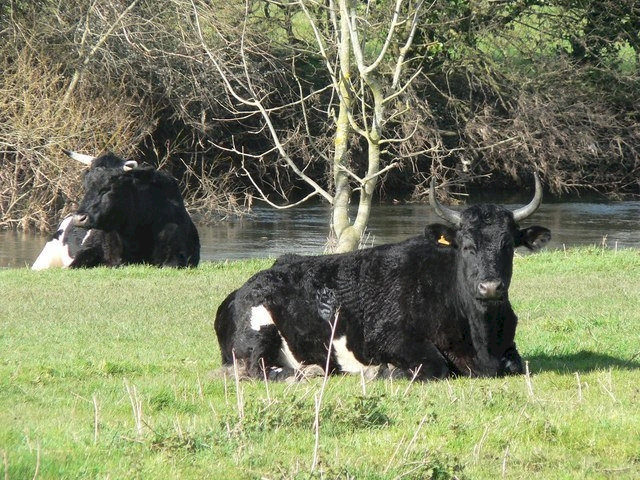Shetland cattle are known for their hardiness and ability to thrive in harsh weather conditions due to its adaptation to the Shetland Islands' climate. They have small, compact bodies and are known for their docile temperaments. The cattle's long, hairy coat protects them during winter and sheds during summer. Breeders find desirable traits in Shetland cattle, such as easy calving and fast growth to adulthood.
Shetland cattle are small in size compared to other breeds, with cows usually weighing between 350-450 kg and bulls weighing between 550-600 kg. They are primarily black and white, but some are red and white or dun and gray. They have distinctive upward-curving horns that are trimmed in commercial production. Their meat and milk are known to contain higher levels of minerals and healthy fatty acids, and lower levels of unhealthy trans fatty acids compared to conventional breeds.
Shetland cattle are used as beef cattle in speciality, niche markets. They are primarily used for beef production, but some individuals may also be used for dairy production. These cattle are usually kept on small-scale farms that rely on a high income from sales and low maintenance costs for feed. The cattle are also still kept by a very small number of self-sufficient people in Shetland. There are currently 800 registered breeding cows and an average of 180 calves born each year. They are considered a heritage breed and have been recognized for their unique characteristics for thousands of years.
The bones of domesticated cattle found in early Shetland settlements reveal evidence of domestication. The joints show traces of arthritis and the teeth have rings of lighter and darker ridges, indicating regular winter hardship. Over time, the size of the cattle started to shrink and by the Bronze Age, two types of cattle appeared in the remains: a larger one and a smaller one. The smaller one was favored and by the Iron Age, it was the only type found in the sites. This animal was just over one meter tall at the shoulder and was described as "a short-legged, stocky, short-horned beast" with a small gene pool. A 1797 court record describes the cattle on a particular farm involved in a legal settlement and based on the description, the cattle were still small like their Iron Age ancestors. Today, Shetland cattle are still small, standing about 1.2 meters tall at the withers, with a light bone structure, thin hide, fine hair, and long tail with a white switch. They were once multicolored, but modern selection has favored black or black and white cattle. A long hairy coat protects them in the winter and is shed in the summer. Shetland cattle have desirable traits such as easy calving and fast growth to adulthood, making them attractive to breeders.
During the period of expansion in the human population, the number of Shetland cattle declined from over 40,000 head in 1808 to less than 15,000 in 1814. The small tenanted farms were reduced in size by the land-owning lairds to increase the number of tenants they could force to undertake the deep-sea fishery. This resulted in a period of starvation and poverty for Shetlanders and their livestock. As the trade in salted, dried fish from the Haaf fishery declined, the lairds cleared off many of their tenants and replaced them with sheep ranching and heavier British cattle breeds where possible. However, the Shetland cow managed to support many families during these difficult times and its special traits enabled it to cope with the extreme conditions.
Despite a revival of interest in the breed in the early 20th century, the Shetland Cattle Herd Book Society was established and a register produced in 1912. However, the society faced difficulties during the First and Second World Wars, and the UK government's decision to not provide subsidies for Shetland cattle made it difficult for the breed to survive. With the evolution of agricultural practices and chemicals, grass became more plentiful for less hardy breeds, leading to cross-breeding and the removal of thousands of native cows. The UK's push for larger cattle and deficiency in the urban proletariat's diet, as revealed by John Boyd-Orr's studies in the 1930s, further contributed to the near destruction of the Shetland cattle breed.
In the 1930s, the UK government, influenced by John Boyd-Orr's studies on the diet of the UK's urban proletariat, made bulls of larger breeds favored by mainland markets available to the Shetland islands. This, combined with the hard economics of the period, led to cross-breeding and nearly wiped out the Shetland cattle. It wasn't until the discovery of oil off Shetland that the breed was saved, mainly through the efforts of T.A.U. Fraser, who started with a stock of four kye and helped re-establish the breed. In 1981, the New Foundation Herd Book and the Shetland Cattle Herd Book Society were established to once again save the breed, with support from the Shetland Islands Council for purebred calves. However, in recent years, the breed's future has been left in the hands of volunteers, as there is no longer any financial support from governments or agencies.
Today, the Shetland cattle breed continues to survive and grow in popularity, with a strong following among small-scale farmers and homesteaders who appreciate their hardiness, adaptability, and unique characteristics. Despite the challenges they faced throughout their history, the Shetland cattle have proved their resilience and value as a breed, and are now valued for their role in preserving biodiversity and supporting sustainable agriculture practices. The SCHBS, along with other organizations and individuals, continue to work towards ensuring the preservation and continued growth of the Shetland cattle population.
Source: Content and Image from Wikipedia.

